
Mathematical ImageryMathematical artists create strong, stunning works in all media and explore the visualization of mathematics
2014 Mathematical Art Exhibition
The 2014 Mathematical Art Exhibition was held at the Joint Mathematical Meetings held in Baltimore, MD. Here on Mathematical Imagery is a selection of the works in various media. Mathematical Art Exhibition Awards were given: "Enigmatic Plan of Inclusion I & II," by Conan Chadbourne was awarded Best photograph, painting, or print; "Three-Fold Development," by Robert Fathauer was awarded Best textile, sculpture, or other medium; and "Blue Torus," by Faye E. Goldman received Honorable Mention. The Award "for aesthetically pleasing works that combine mathematics and art" was established in 2008 through an endowment provided to the American Mathematical Society by an anonymous donor who wishes to acknowledge those whose works demonstrate the beauty and elegance of mathematics expressed in a visual art form.
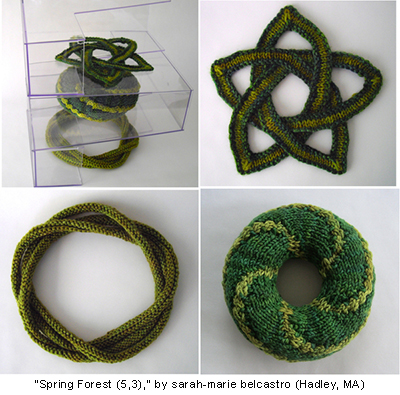
Embedded, unembedded, and cowl; 12" x 11" x 9", Knitted wool (Dream in Color Classy, in colors Happy Forest and Spring Tickle), 2009 and 2013. A (p,q) torus knot traverses the meridian cycle of a torus p times and the longitudinal cycle q times. Here are three instantiations of a (5,3) torus knot: (a, middle) The knot embedded on a torus. A (p,q) torus knot may be drawn on a standard flat torus as a line of slope q/p. The challenge is to design a thickened line with constant slope on a curved surface. (b, top) The knot projection knitted with a neighborhood of the embedding torus. The knitting proceeds meridianwise, as opposed to the embedded knot, which is knitted longitudinally. Here, one must form the knitting needle into a (5,3) torus knot prior to working rounds. (c, bottom) The knot projection knitted into a cowl. The result looks like a skinny knotted torus. --- sara-marie belcastro
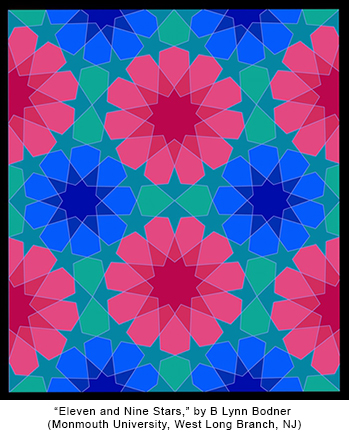
20" x 16", paper and ink computer-generated image, 2013. Geometric Islamic patterns, especially those consisting predominantly of star polygons, fascinate me. This pattern was created using Euclidean construction techniques and the electronic equivalent of the compass and straightedge. It was based on a rectangular repeat unit sketch known as Catalog Number 42 (CN42) of the Topkapi Scroll, which contains 114 Islamic architectural and ornamental designs dating from the 15th or 16th century. CN42 has half 11-stars along its vertical edges and half 9-stars along its horizontal edges. To achieve a complete pattern, this repeat unit must be replicated by reflection across its edges. The image displayed here contains four colored copies of the CN42 repeat unit. Since CN42 is the only sketch in the Topkapi Scroll containing 11-pointed star polygons, it was one of the more challenging ones to recreate. --- B. Lynn Bodner

13" x 13", digital print, 2013. Visualization is an important aid in the study of mathematics. Each of the disks in the $3 \times 3$ matrix of disks is a picture of the first five backward iterations of $f(z)=z^n+c/z^m$ where $c$ is a small positive real number. The rows represent $n=2,3,4$ and the columns represent $m=2,3,4$. The black disks in the center consist of the set of points $z$ such that $|f(z)|>1.1$. The second largest sets of disks are blue; they are the inverse images of the black disks under $f$; ochre disks are the inverse images of blue disks; red disks are the inverse images of ochre disks, etc. First notice the $n+m$ symmetry in each disk. Next, can you identify $n$ and $m$ by this pattern? Hint: choose one blue disk in each entry and count the number of pre-images closer to the center and the number of pre-images further away from the center. -- Anne Burns

12cm x 12cm x 12cm, 3D printer, 2013. Most people view mathematics as a collection of tools and procedures and get mired in the mechanics. Mathematical art communicates the essential beauty found in mathematics. The Lorenz attractor is the limiting set of a three-dimensional system of differential equations modeling atmospheric convection. Discovered by Ed Lorenz in 1962, this set has become an attractive symbol for chaotic dynamics. The art work was created by modifying Mathematica code developed by Knill and Slavkovsky. An important new component was to have the curve which generates the shape continuously change color. This allows the observer to see the flow of motion as the attractor is generated. --- Marc Chamberland and Chris French
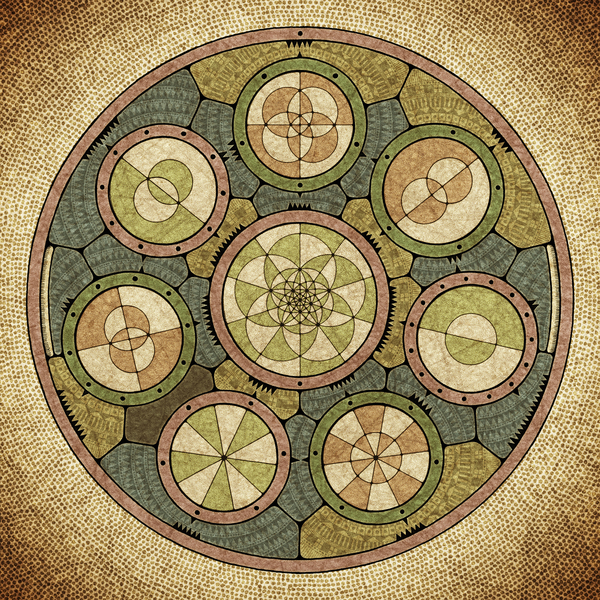

[Above pair:] Best photograph, painting, or print - 2014 Mathematical Art Exhibition
24" x 24", archival inkjet print, 2013. My work is motivated by a fascination with the occurrence of mathematical and scientific imagery in traditional art forms, and the frequently mystical or cosmological significance that can be attributed to such imagery. These images are investigations of the subgroup structure of the icosahedral group (A5). At the center of each image is a graphical representation of A5, as formed by orientation-preserving pairs of reflections in circles and lines in the plane. This is surrounded by similar graphical representations of the seven conjugacy classes of (proper, non-trivial) subgroups of A5, with the trivial group depicted as the space outside of the large circular frame. The interstices between the group images indicate the relationships of inclusion between the different groups, with colors being used to distinguish maximal subgroup relationships, and small graphical markers used to indicate the particular numbers of conjugates involved in each relationship. --- Conan Chadbourne

Best textile, sculpture, or other medium - 2014 Mathematical Art Exhibition
13" x 13" x 13", ceramics, 2013. I'm endlessly fascinated by certain aspects of our world, including symmetry, chaos, and infinity. Mathematics allows me to explore these topics in distinctive artworks that I feel are an intriguing blend of complexity and beauty. This sculpture is based on the first five generations of a fractal curve. The starting point is a circle, and the first iteration produces a three-lobed form. With each iteration, the number of lobes is tripled. The spacing between features is essentially constant throughout a layer, while the three-fold symmetric boundary of the curve becomes increasingly complex. A hexagonal version of this curve is found in Benoit Mandelbrot's book "The Fractal Geometry of Nature". This hyperbolic surface is reminiscent of naturally-occurring corals. It was inspired in part by a 3D-printed model created by Henry Segerman. --- Robert Fathauer
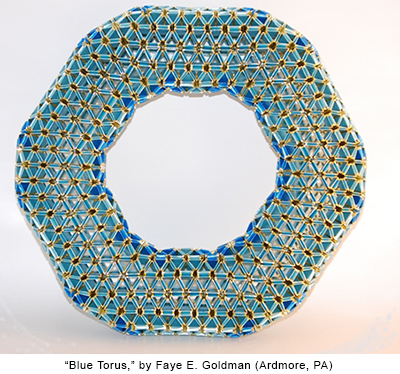
Honorable Mention - 2014 Mathematical Art Exhibition
10" x 10" x 2.5", strips of ribbon, 2011. I was drawn to modular origami by its structure and mathematical properties. More recently I found the Snapology technique by H. Strobl, which allows great creativity with very few rules using only strips of material? It has provided insights into mathematical ideas. This toroid shape is made from over 2400 strips of ribbon. It was the first non-convex shape I've made. I love the fact that there needs to be as many heptagons making the negative curvature in the center as there are pentagons around the outside. --- Faye Goldman
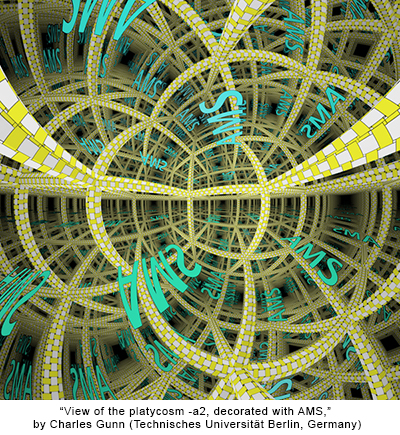
18" x 18", print of computer image, 2013. I enjoy exploring two- and three-dimensional tessellations -- euclidean, spherical and hyperbolic, especially the "insider's" view of such spaces. I have been experimenting recently with alternative perspective rendering based on a spherical canvas surrounding the viewer. This is an insider's view of the platycosm -a2. ("Platycosm" is John Conway's term for a compact euclidean 3-manifold.) This platycosm is generated by a translation, a glide reflection and a screw motion with order-2 rotational part, in three mutually perpendicular directions. The fundamental domain is a cube, whose edges are rendered via the textured beams. The "geometry" consists of the initials AMS, in honor of one of the hosting orgranizations of the art show. The image is rendered conformally from the viewable sphere of an insider positioned in the scene. I sometimes call this "six-point perspective" rendering since one may see vanishing points not just in the x,y, and z directions but also in the -x, -y, and -z directions. --- Charles Gunn
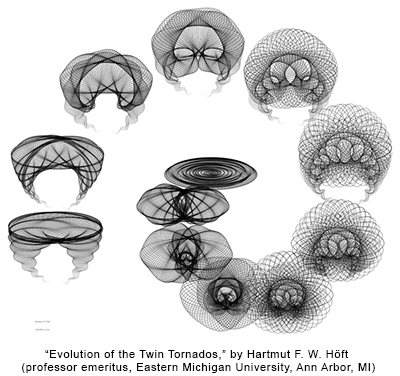
7.5" x 9" (10.5" x 12" framed), archival photographic digital paper, 2013. I like to experiment with simple planar geometric figures. Starting with one outline I move it, rotate it, and change its proportions. In this picture 12 images are arranged in a spiral. A primordial sea in the center starts the process. One parameter of the spine function increases, then stays constant, while the other increases and then decreases again. As the sequence progresses along the spiral the spine function increases in complexity so that the images billow out like clouds and then start separating into two funnels as the second parameter decreases again. Each image on the spiral is composed of 289 ellipses with a closed spine curve though it does not appear to be closed since the axes of the elipses decrease to zero at the bottom. The graphics were rendered in Mathematica 8 and printed on archival, photographic digital paper. --- Hartmut F. W. Höft
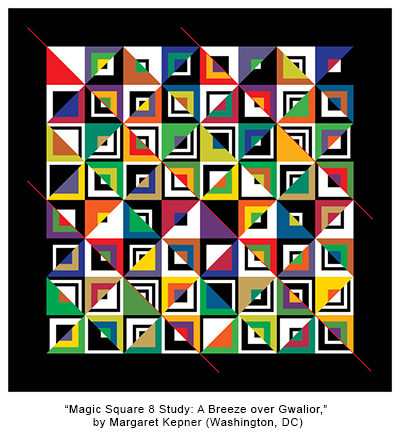
20" x 20", archival inkjet print, 2013. I enjoy exploring the possibilities for conveying ideas in new ways, primarily visually. I have a background in mathematics, which provides me with a never-ending supply of subject matter. This work is based on a magic square of order 8, expressed in a visual format similar to a traditional quilt pattern. The magic square, known as the Gwalior Square, is an 8x8 array of numbers from 0 to 63, such that every row and column adds up to 252, the 'magic constant.' The two main diagonals, as well as every broken diagonal, also sum to 252. The numbers in the square are represented in base 2 and base 4. Nested squares serve as the number places in the base systems, and suggest the Log Cabin quilt structure. For each of the 64 squares, half is shown in base 2 and the other half in base 4. The squares are oriented to create the 'pinwheel' quilt pattern. This pattern groups together 2x2 arrays of 4 numbers, all of which sum to 126. --- Margaret Kepner

Spherical, 18" in diameter, medium-density fiberboard, 2013. The Platonic solids have been the inspiration for the pieces I have created thus far. My work explores the structure of these objects and their relationships to one another, and attempts to express this structure in a way that is aesthetically appealing. Take either the icosahedron or dodecahedron and center it at the origin. Project its vertices outward from the origin onto the surface of a sphere surrounding it, giving a collection of points on a sphere. Draw a great circle through two points if they are images of two adjacent vertices in the original polytope. Each of these great circles is partitioned into arcs by its intersection with the other great circles thus produced. The arcs come in three lengths and are projections of the edges of, respectively, an icosahedron, a dodecahedron, and a third polytope whose facets are rhombic. This model exhibits this construction. The convex arcs correspond to the icosa, the concave to the dodeca, and the straight to the rhombic. --- Jack Love
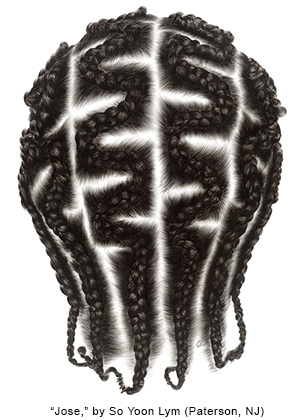
22" x 30", acrylic on paper, archival pigment print, 2009. The Dreamtime is inspired by the Aboriginal stories and visions of creation. Each braided pattern, carried by the students, is a map of the ancient universe, a topographical palimpsest of the world in pattern: valleys, mountains, forests, oceans, rivers, streams. Dr. Ron Eglash's work in ethnomathematics is behind my hair and braid painting. --- So Yoon
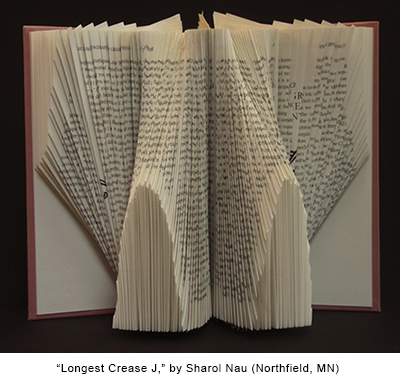
10" x 10" x 10", book sculpture, 2013. A classical calculus problem, the so-called Paper Creasing Problem, deals with extremizing the length of the crease formed when a rectangular sheet of paper is altered by folding one corner, say the lower right-hand corner, to the opposite edge. The length of the crease depends on the distance the active corner is from the upper left-hand corner. This sculpture formed by folding individual pages is an example of the variety of the three-dimensional forms which can be obtained by incremental changes in the length of the crease from page to page and by extending the points that can be used. --- Sharol Nau
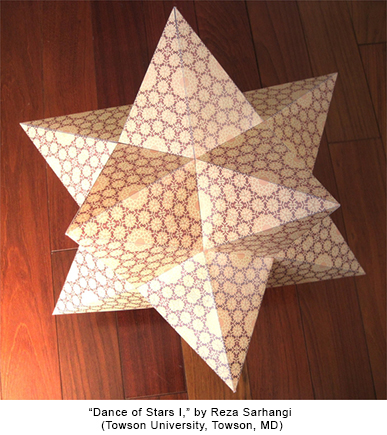
12" x 12" x 12", heavy paper, 2013. I am interested in Persian geometric art and its historical methods of construction. Dance of Stars I is one of the Kepler-Poinsot polyhedra, the Small Stellated Dodecahedron, with Schläfli Symbol (5/2, 5). It has been ornamented by the sâzeh modular tiles, that are used in a majority of tiling that conform to local five-fold symmetries. In an article that appeared in Science, the authors proposed the possibility of the use of a set of tiles, girih tiles, by the medieval craftsmen, for the composition of the underlying pattern. Ink outlines for these girih tiles appear in panel 28 of the Topkapi scroll. I used girih tiles and left the dashed outlines in the final tessellation. I also included rectilinear patterns that appear as an additional small-brick pattern in the decagonal Gunbad-i Kabud tomb tower in Maragha, Iran. --- Reza Sarhangi (1952-2016)
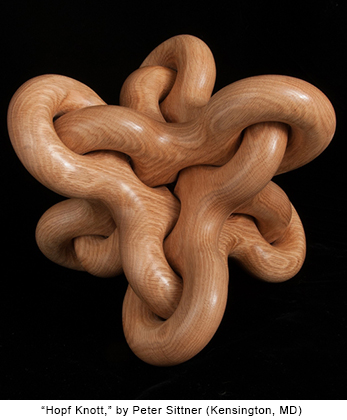
13.5" x 13.5" x 13.5", red oak, 2013. Hopf Knott is the offspring of two forms that have intrigued me for some time, the Hopf Link and the Borromean Rings. While the sculpture may appear to be a series of connected Hopf Links, it is actually two sets of Borromean Rings, an inner set and an outer set. Of course, the "rings" are stretched to make the crossings possible and shaped to resemble Hopf Links. The 6 outermost points correspond to the vertices of a regular octahedron. --- Peter Sittner


